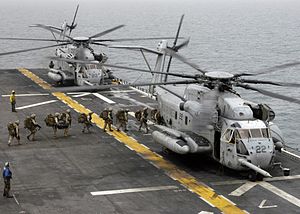
The Sikorsky CH-53E Super Stallion is the largest and heaviest helicopter in the United States military. As the Sikorsky S-80 it was developed from the CH-53 Sea Stallion, mainly by adding a third engine, adding a seventh blade to the main rotor and canting the tail rotor 20 degrees. It was built by Sikorsky Aircraft for the United States Marine Corps. The less common MH-53E Sea Dragon fills the United States Navy's need for long range minesweeping or Airborne Mine Countermeasures (AMCM) missions, and perform heavy-lift duties for the Navy. Under development is the CH-53K King Stallion, which will be equipped with new engines, new composite material rotor blades, and a wider aircraft cabin.
The CH-53 was the product of the U.S. Marines' "Heavy Helicopter Experimental" (HH(X)) competition begun in 1962. Sikorsky's S-65 was selected over Boeing Vertol's modified CH-47 Chinook version. The prototype YCH-53A first flew on 14 October 1964. The first CH-53As were powered by two General Electric T64-GE-6 turboshaft engines with 2,850Â shp (2,125Â kW) and had a maximum gross weight of 46,000Â lb (20,865Â kg) including 20,000Â lb (9,072Â kg) in payload.